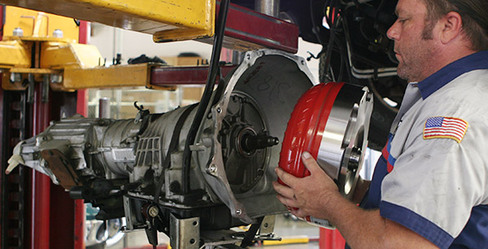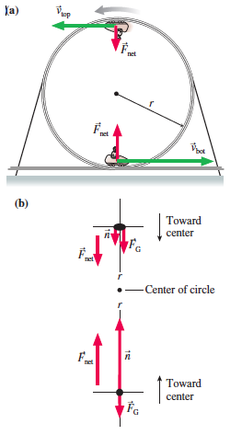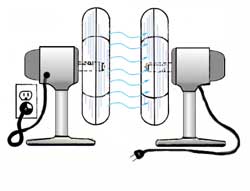The Physics - Why it Works
Why the Fluid Moves Outwards
|
As the impeller spins, along with the torque converter as a whole, the fluid within it is forced outwards. This is known as centrifugal force. This centrifugal force is what is known as a fictitious force. According to Randall Knight, fictitious forces "are not real forces because no agent is exerting them, but they describe your motion relative to a non-inertial reference frame." This centrifugal force can be thought of as the same force that keeps the water inside a bucket when one spins the bucket in vertical circles, or how a roller coaster can go upside down in a loop-de-loop, as seen to the right.
As the body of the torque converter and the impeller spin, as seen in the diagram to the right, the fluid will have a velocity tangental to its position at any point, and a net force always pointing towards the center of rotation, thus the fluid is forced to the outside of the torque converter walls Energy from Impeller to FluidThe fins of the impeller contact the fluid, and the fluid is forced down the fins then away from the impeller at an angle determined by the fin shape and angle of the impeller by the fluid moving in behind it as with the centrifugal forces pushing the fluid outward. This type of collision is classified as an inelastic collision, here we will assume it is perfectly inelastic. In an inelastic collision, momentum is conserved. This is shown by:
Pi=Pf
where Pi = initial momentum and Pf = final momentum From this we can determine that: (M1*V1i) + (M2*V2i)=((M1+M2)*Vf) Where M = mass, V = velocity, object 1 = impeller, object 2 = fluid, i = initial, f = final The figure to the right (labeled figure 9.18) shows an inelastic collision. This equation of conservation of momentum assumes that no energy is lost in the collision, such as heat from friction. Here we can see that as the fluid contacts the impeller between fins, it is forced along by the fin and now moves with the same velocity as the fin. As new fluid moves in behind, the original fluid is pushed out by centrifugal force. It will eventually be forced outside of the impeller, where it is then forced towards the turbine.
Energy from Fluid to TurbineAs the fluid is now forced toward the turbine, it contacts the fins of the turbine just as it did the fins of the impeller, but now the equation works in the opposite direction, as the fluid now hits the fins of the turbine and forces it to begin to spin by transferring much of its energy to it. The same type of inelastic collision now occurs, except now the angle and shape of the turbine fins force the fluid inwards.
Fluid from Turbine to StatorAs mentioned earlier, when the fluid exits the turbine, it is flowing in a direction opposing the impeller. This must be corrected to maximize efficiency. As the fluid hits the fins of the stator, an elastic collision occurs. The fluid hits the fins and is deflected about 90 degrees, depending on the design of the stator. This elastic collision can be modeled by:
(M1*V1i) + (M2*V2i)=(M1*V1f) + (M2*V2f)
|
Energy LossEnergy entering the torque converter doesn't equal the energy exiting the torque converter and going to the transmission. Conservation of mechanical energy holds true, but some energy is lost to heat due to friction. This can be modeled as:
KE(rot)i=KE(rot)f +E(th)
KE(rot)= Iw^2 Where I = the moment of inertia, w= angular velocity, E(th) is thermal energy caused by friction, i = initial (measured at impeller) and f = finial ( measured at turbine) This shows us that energy is lost within the torque converter, as it is not 100% efficient. To prevent that a lockup clutch is needed.
See it for Yourself!Want to see the principal of the impeller and turbine yourself? Take 2 fans and position them facing each other at a very close distance (few inches at most). Turn one fan on high, and leave the other off. You'll see that the fan you left off begins to rotate from the air the turned on fan blows against its blades, but it doesn't spin the same speed! Not only have you now shown that a torque converter works, you've shown energy isn't conserved with this system because the fans spin different speeds!
|



